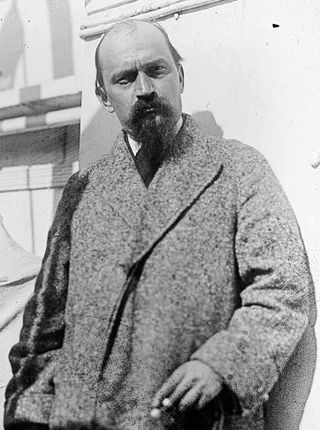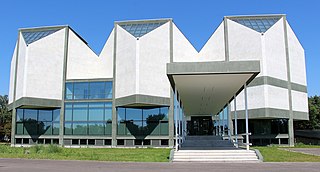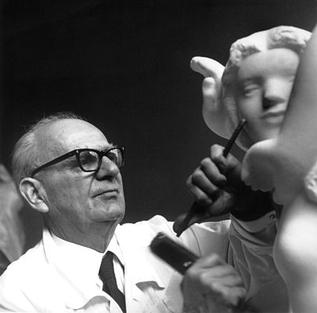
Ivan Meštrović was a Croatian and Yugoslav sculptor, architect, and writer. He was the most prominent modern Croatian sculptor and a leading artistic personality in contemporary Zagreb. He studied at Pavle Bilinić's Stone Workshop in Split and at the Academy of Fine Arts Vienna, where he was formed under the influence of the Secession. He traveled throughout Europe and studied the works of ancient and Renaissance masters, especially Michelangelo, and French sculptors Auguste Rodin, Antoine Bourdelle and Aristide Maillol. He was the initiator of the national-romantic group Medulić. During the First World War, he lived in emigration. After the war, he returned to Croatia and began a long and fruitful period of sculpture and pedagogical work. In 1942 he emigrated to Italy, in 1943 to Switzerland and in 1947 to the United States. He was a professor of sculpture at the Syracuse University and from 1955 at the University of Notre Dame in South Bend, Indiana.
Matija Vuković was a Serbian sculptor.

The National Museum of Serbia is the largest and oldest museum in Belgrade, Serbia. It is located in the central zone of Belgrade on a square plot between the Republic Square, formerly Theatre Square, and three streets: Čika Ljubina, Vasina and Laze Pačua. Its main facade is on the Republic Square and the official address ia 1a Republic Square.

Antun Augustinčić was a Croatian sculptor active in Yugoslavia and the United States. Along with Ivan Meštrović and Frano Kršinić, he is considered one of the three most important Croatian sculptors of the 20th century. His most notable sculptures include the Peace monument which stands in front of the United Nations building in New York City, the Miner statue in front of the International Labour Organization headquarters in Geneva, and the sculpture of Yugoslav president Josip Broz Tito, present in several copies throughout former Yugoslavia.

The Museum of Contemporary Art is an art museum located in Belgrade, Serbia. It was founded in 1958 as the Modern Gallery, making if one the first museums of this type in the world. It was moved into the current building in the Ušće neighborhood of New Belgrade in 1965. The building is a masterpiece of architects Ivan Antić and Ivanka Raspopović, a short-lived but highly successful partnership, which also produced the 21 October Museum in Šumarice Memorial Park in Kragujevac. The collection contains more than 35,000 works of art.

Dimitrije Popović is an eminent Montenegrin and Croatian painter, sculptor, art critic and philosopher born in Cetinje, Montenegro. He attended elementary and high school in his hometown and graduated from the Academy of Fine Arts in Zagreb in 1976 in the class of professor Šime Perić.

Robert Baća was a Croatian sculptor and painter. Baća graduated from the academy in Zagreb in 1974. He was an assistant at the Antun Augustinčić masterworks. He worked in sculpture and abstract ceramics with associative nuances and accented dimensions.. He also worked with coloured porcelain objects. He has exhibited his works in Zagreb, Samobor, Sesvete, Sisak, Zürich and Liechtenstein.

Croatian art of the 20th century, that is visual arts within the boundaries of today's Croatia, can be divided into modern art up to the Second World War, and contemporary art afterwards.
The Marinko Sudac Collection, based in Zagreb, Croatia, has been created with a clear collecting strategy based on the region of Central and Eastern Europe, additionally spanning from the Baltic area to the Black Sea. The guiding principle of the Collection is systematic exploration, researching, and promotion of the avant-garde practices which have been marginalized, forbidden, and at times completely negated due to the historical, social and political circumstances. In this context, the Marinko Sudac Collection gives the most complete and comprehensive overview on the art of this region. The Collection starts at 1909, and it show the continuity from the first Avant-Gardes, through neo-avant-garde and New Artistic Practices, ending with the fall of the Berlin Wall. The global uniqueness of the Marinko Sudac Collection is also seen in the kind of media it contains. It contains not only traditional artworks, such as paintings, sculptures, and photographs, but it gives equal importance to documentary and archival material. Great importance is put on these almost forgotten media, which enable research of specific phenomena, artists and the socio-political situation which affected this type of art. The Collection contains a great number of museological units, and it treats the documentary and archival material on the same level as traditional artworks. By examining the units contained in the Marinko Sudac Collection, one can read not only the art scene or the art production of a certain artist, but the full status of the society, the socio-political atmosphere of the region in which this art was created in.
The Greatest Croatian was an open-access poll conducted over five weeks in 2003 by the Croatian weekly Nacional.

Frano Kršinić was a Croatian sculptor active in former Yugoslavia. Along with Ivan Meštrović and Antun Augustinčić, he is considered one of the three most important Croatian sculptors of the 20th century. His most widely known work is the statue of Nikola Tesla installed at the Niagara Falls State Park, United States, an identical copy of the monument residing in front of the building of the School of Electrical Engineering, University of Belgrade (Serbia).
The Earth Group was a Croatian arts collective active in Zagreb, Croatia from 1929 to 1935, when it was banned. The group aimed to defend their artistic independence against foreign influences such as Impressionism or Neoclassicism and art for art's sake. They maintained that art should mirror the social milieu from which it springs and should meet contemporary needs, hence their emphasis on the popularization of art, both at home and abroad. In spite of its ideologically heterogeneous membership, the group was considered Marxist in orientation but never espoused socialist realism.

The Academy of Fine Arts Zagreb is a Croatian art school based in Zagreb. It is one of the three art academies affiliated with the University of Zagreb, along with the Academy of Dramatic Art (ADU) and the Academy of Music (MUZA).

Modern Gallery is a museum in Zagreb, Croatia that holds the most important and comprehensive collection of paintings, sculptures and drawings by 19th and 20th century Croatian artists. The collection numbers around 10,000 works of art, housed since 1934 in the historic Vranyczany Palace in the centre of Zagreb, overlooking the Zrinjevac Park. A secondary gallery is the Josip Račić Studio at Margaretska 3.

Ivan Meštrović Gallery, is an art museum in Split, Croatia dedicated to the work of the 20th-century sculptor, Ivan Meštrović. The gallery preserves and presents to the public the most significant works of Meštrović, and is in itself an art monument. The permanent collection includes works of sculpture, drawings, design, furniture and architecture. Holdings include original plaster models by the artist, as well as finished works in bronze, marble and wood. The gallery building and grounds were based on original plans by Meštrović himself, and included living and working areas, as well as exhibition spaces.
Ivan Picelj was a contemporary Croatian painter, sculptor and graphic designer.

Vojin Bakić was a prominent Yugoslav sculptor.
Vilko Gecan was a Croatian painter, influential in the Zagreb modern art scene of the 1920s and 1930s. He is best known for his expressionist paintings and drawings, and for his contributions to the local avantgarde magazine Zenit. He showed his work in many solo and group exhibitions in Croatia and abroad. In the Zagreb Spring Salon of the 1920s, he participated with Milivoj Uzelac, Marijan Trepše and Vladimir Varlaj, who together were known as the "Group of Four" or "The Prague Four". Trained in Prague, works of these young painters brought new expressionist ideas that went on to dominate the 1920s Croatian art scene.
Oton Postružnik (1900–1978) was a Croatian artist, painter, graphic artist, and ceramist. He was one of the founding members of the Earth Group artist collective in Zagreb from 1929 to 1933. He studied in Zagreb, Prague and Paris, and was a professor at the Academy of Fine Arts in Zagreb from 1950 to 1970. He is best known for his abstract paintings of natural subjects, such as his Leaf series.

The Pietà is a marble statue by Croatian artist Ivan Meštrović housed in the Basilica of the Sacred Heart on the campus of the University of Notre Dame. It is considered one of his most celebrated works. Meštrović conceived the work while imprisoned in Zagreb by the Ustaše and then sculpted it in Rome from a six ton block of Carrara marble. It is hence also known as Roman Pieta. Meštrović also made several copies of the work which are now held at the Ivan Meštrović Gallery, Vatican Museums, and Pontifical Croatian College.














